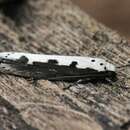pt-BR
nomes no trilho de navegação


Ethmia bipunctella is a diurnal moth from the family Depressariidae. It can be found in Central and Southern Europe, North Africa, Asia and the northeastern part of North America. E. iranella was formerly included here as a subspecies.
The wingspan of the moth ranges from 19–28 millimetres (0.75–1.10 in). The flight time ranges from May to September. The moth is bivoltine, having two generations per year.
The most important host plant is the viper's bugloss, but also Anchusa officinalis and plants from the genus Symphytum. Pupae are attached to dead wood.
Ethmia bipunctella is a diurnal moth from the family Depressariidae. It can be found in Central and Southern Europe, North Africa, Asia and the northeastern part of North America. E. iranella was formerly included here as a subspecies.
 Caterpillar
Caterpillar The wingspan of the moth ranges from 19–28 millimetres (0.75–1.10 in). The flight time ranges from May to September. The moth is bivoltine, having two generations per year.
The most important host plant is the viper's bugloss, but also Anchusa officinalis and plants from the genus Symphytum. Pupae are attached to dead wood.